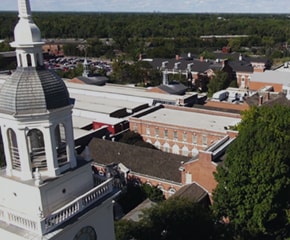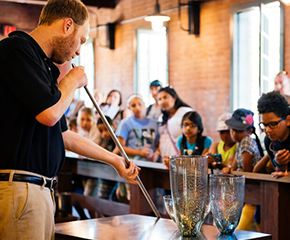
Behind the Scenes at
With Liberty & Justice for All
No idea is more fundamental than freedom to Americans’ sense of themselves as individuals and as a nation. But the story of American freedom is not a clear progression to a preordained goal. It is a tale of debates, disagreements and struggles between individuals and groups of people with different ideas and points of view. It is as multifaceted, contentious and ever-changing as America itself. And it continues today.
Our With Liberty & Justice for All exhibit focuses upon four key transformative moments in the American quest for freedom: the Revolutionary Era, the Antislavery Movement and Civil War Era, the Woman’s Suffrage Movement, and the Civil Rights Movement. It highlights the people and iconic artifacts that were involved in those moments, and involves visitors in the important debates and struggles.
Freedom in America has always been the product of social movements and struggle. Groups of people coalesce around a progressive idea or issue and strategies and leaders emerge. Recognized as articulate, effective and charismatic at the time, these all-too-human leaders soon become symbols of the movement and are seen as super-human icons of freedom in the later glow of historical hindsight.
The United States has been fortunate in having leaders at specific moments in history who transcend their times. On the world historical stage, Thomas Jefferson, George Washington, Abraham Lincoln and Martin Luther King could hold their own with the leaders of any nation at any time. Each found himself facing contradictory events and ideas about the human condition; the realities did not match the progressive ideals of the day. Each one was historically informed and morally driven, ideologically inspired and politically pragmatic, personally persuasive and rhetorically gifted. More importantly, each wanted to affect change in the real world. As leaders, they were inspired by their predecessors, propelled to the forefront by the mass of people, then transcended the group and articulated a new brand of freedom that exceeded the nation’s expectations.
Thomas Jefferson was asked to prepare a document enumerating charges against King George III merely because he was recognized as a good writer. He produced a revolutionary statement of human freedom far beyond what was expected of him. Thomas Paine preceded him as the inspirational pamphleteer of human rights.
George Washington was asked to lead the Continental army because he was an experienced military leader with a sound knowledge of the geography of colonial America. He became a symbol of the army he led, the independence they won, and the nation they founded. Washington recognized the importance of a central government formed by a written constitution (still the living embodiment of democracy) and then insisted upon a limited role for the presidency.
Abraham Lincoln faced the test of keeping the “American Experiment” united but simultaneously decided that the way to do that was to extend the prevailing notions of who could be free, to redefine the very notions of the nation and freedom. Abolitionists John Brown and Frederick Douglass showed him the way.
Inspired by Rosa Parks, the Reverend Martin Luther King, Jr. initially simply ratified the sentiments of local civil rights advocates who wanted a fair bus system. He soon elevated that movement into a demand for full civil rights, ultimately for integration between the races and, finally, to a quest for social justice based on race and class.
While these are the individuals who have come to symbolize American freedom, they have had their own mentors, antagonists and heirs. They exist in a continuum of “freedom movements” and “freedom fighters” that span American history.
These powerful stories—with their inspirational leaders and galvanizing moments—provide the compelling core and the framework for the exhibition. These stories come alive through highly emotional, dramatic storytelling techniques punctuated by rare and iconic artifacts from the Museum’s collections, including:
- One of the few surviving copies of the Declaration of Independence
- George Washington’s camp chest and bed
- A hand-lettered copy of the 13th Amendment to the Constitution (which declares freedom for slaves)
- The chair in which Abraham Lincoln was sitting when he was assassinated
- The bus on which Rosa Parks was riding in December 1955, when she made her historic stand for civil rights
Hundreds of additional compelling artifacts from the Museum’s collection are also highlighted throughout the exhibit. We invite visitors to become actively involved in the historical debates about American freedom through a series of highly interactive exhibit techniques. As you learn about and engage in these debates, disagreements and struggles about freedom, you’ll realize that not only has the meaning of American freedom changed greatly over time, but that you yourself may have strong opinions about it. And perhaps, like many great Americans throughout history, you will be inspired to take some action in your life to affect change in the world.


